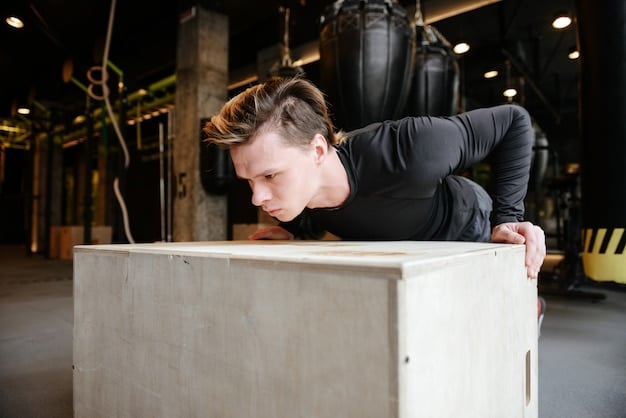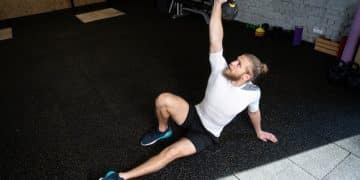Increase Vertical Jump by 10%: The Jump Training Routine

Achieving a 10% increase in vertical jump involves a structured jump training routine that combines plyometrics, strength training, and specific technique drills to enhance explosive power and coordination.
For athletes and enthusiasts alike, the quest to boost vertical leap is often a driving force in training. A significant increase vertical jump by 10%: the jump training routine is not merely about jumping higher; it’s about unlocking new levels of athletic potential through a systematic approach that refines power, strength, and technique.
The Science Behind Vertical Jump Improvement
The vertical jump is a complex athletic movement, rooted in the coordinated effort of numerous muscle groups and a critical interplay of force production and absorption. Understanding the underlying biomechanics and physiological adaptations is paramount to designing an effective training program. It’s not just about raw power; it’s about how efficiently that power is generated and transferred.
neuromuscular efficiency
The ability of the nervous system to quickly and effectively recruit and fire muscle fibers is crucial for explosive movements. Training focuses on improving the communication between the brain and muscles:
- Motor unit synchronization: The simultaneous activation of muscle fibers leading to greater force production.
- Rate coding: Increasing the frequency at which motor neurons fire, enhancing muscular contraction speed.
- Inhibition of protective reflexes: Reducing the natural protective mechanisms that limit maximum force output.
muscular power and strength
While strength provides the foundation, power – the rate at which work is done – is directly correlated with jump height. Training aims to build both:
- Maximal strength: The ability to exert maximum force, often developed through heavy resistance exercises.
- Rate of force development (RFD): How quickly muscles can generate force, which is key for explosive movements.
Developing these attributes means focusing on compound movements that recruit large muscle groups and incorporating exercises that demand rapid, forceful contractions. This synergy between strength and power is what truly translates into a higher vertical leap.
The goal is to enhance the body’s natural spring-like mechanism. This involves building robust hamstrings, quadriceps, and glutes, while also ensuring the core musculature can stabilize and transfer force efficiently. Effective vertical jump training integrates these components into a cohesive strategy, moving beyond simplistic concepts to a nuanced understanding of athletic performance. A comprehensive approach addresses not only the prime movers but also the supporting systems that contribute to explosive movement.
Building Blocks: Key Components of Your Routine
To truly achieve a significant increase in vertical jump, a training routine must be multifaceted, targeting various physiological aspects of athletic performance. This isn’t a one-size-fits-all approach but rather a strategic blend of different training modalities designed to synergistically enhance explosive power. Each component plays a vital role in developing the complete athlete capable of maximal vertical expression.
plyometric training for explosiveness
Plyometrics are the cornerstone of jump training, focusing on short, explosive movements that utilize the stretch-shortening cycle. This involves rapidly stretching a muscle (eccentric phase) immediately followed by a powerful contraction (concentric phase). Effective plyometrics improve reaction time and force production:
- Depth jumps: Stepping off a box and immediately jumping for height upon landing.
- Box jumps: Jumping onto a box from a standing start, focusing on soft landings.
- Broad jumps: Horizontal jumps that reinforce full-body power and coordination.
Proper form and progressive overload are crucial to prevent injury and maximize gains. The intensity of plyometric drills should be carefully managed to ensure optimal adaptation without overtraining.
strength training for foundational power
Strength provides the platform upon which power is built. Developing maximal strength in key lower body muscles is indispensable for generating the force needed to propel the body upwards. Exercises should focus on compound movements:
- Squats (back, front, goblet): Builds overall lower body and core strength.
- Deadlifts (conventional, sumo, Romanian): Develops posterior chain strength.
- Lunges (forward, reverse, lateral): Improves unilateral strength and stability.
These exercises should be performed with appropriate weight and technique to ensure muscle hypertrophy and neurological adaptations that contribute to greater force production. Consistency is key in strength development, as is gradually increasing the load to challenge the muscles effectively.
technique and landing mechanics
Beyond raw power, proper mechanics significantly impact jump height and injury prevention. A strong focus on technique ensures that all power generated is channeled efficiently into upward movement:
- Arm swing synchronization: Coordinated arm movement adds significant momentum to the jump.
- Landing control: Learning to absorb impact safely is vital for joint health and readiness for subsequent jumps.
Practicing the jump itself, with attention to the dip, explosion, and landing, refines muscle memory and optimizes performance. The ability to land softly and properly distribute impact forces safeguards the knees and ankles, allowing for consistent high-intensity training. Integrating these components into a cohesive routine will not only boost your vertical jump but also build a more resilient and powerful physique.
The 8-Week Jump Training Routine
This 8-week program is structured to progressively overload the body, combining strength, plyometrics, and technique drills to maximize vertical jump potential. Each week builds upon the last, gradually increasing intensity and complexity. Consistency and proper recovery are paramount for success and injury prevention.

week 1-2: foundation and adaptation
The initial phase focuses on establishing a solid strength base and introducing the body to plyometric movements at a lower intensity. This allows for adaptation and honing of basic mechanics.
- Strength: 3 sets of 5-8 reps for squats, deadlifts, and lunges (70-80% 1RM).
- Plyometrics: 3 sets of 8-10 reps for broad jumps and pogo jumps (low intensity).
- Core: 3 sets of 15-20 reps for planks, Russian twists, and leg raises.
Focus should be on perfect form, even if it means reducing the weight or intensity. This foundational period is crucial for setting the stage for more intense work to come, developing muscle memory and preparing connective tissues for greater demands.
week 3-4: increasing intensity and volume
This phase increases the challenge, pushing the body to generate more force and recover more effectively. The volume and intensity of plyometric exercises rise, alongside maintaining strength gains.
- Strength: 3-4 sets of 4-6 reps for squats, deadlifts, and step-ups (80-85% 1RM).
- Plyometrics: 3-4 sets of 5-8 reps for box jumps (medium height), depth drops (no jump), and continuous broad jumps.
- Technique: Practice full vertical jumps, focusing on arm swing and dip.
Recovery becomes even more critical during this period. Adequate sleep, nutrition, and hydration support muscle repair and adaptation, ensuring that the body can handle the increased workload effectively. Listening to your body and adjusting as needed is key.
week 5-6: peak power and reactive strength
This is where the program zeroes in on explosive power. Plyometrics become more complex and reactive, while strength training maintains a lower rep range for maximal force production.
- Strength: 3-4 sets of 3-5 reps for power cleans or jump squats (lighter weight, explosive execution).
- Plyometrics: 3-4 sets of 3-5 reps for depth jumps (with immediate jump), hurdle hops, and single-leg box jumps.
- Auxiliary: Calf raises (weighted), hamstring curls, glute bridges.
The nervous system is heavily taxed during this phase, so quality of movement takes precedence over quantity. Each repetition should be performed with maximum intent and explosive effort.
week 7-8: tapering and testing
The final two weeks are about refinement and preparing the body for peak performance. Intensity remains high but volume decreases to allow for full recovery and supercompensation.
- Strength: 2-3 sets of 2-3 reps for key lifts, focusing on speed and form.
- Plyometrics: 2-3 sets of 2-3 reps for high-intensity box jumps and depth jumps.
- Testing: At the end of week 8, perform a pre-post test to measure vertical jump improvement.
This tapering period allows the body to fully recover and unleash its newly acquired power. It’s a time to trust the training and focus on mental preparation, knowing that the hard work has laid the groundwork for significant gains.
Nutrition, Recovery, and Injury Prevention
Achieving a 10% increase in vertical jump isn’t solely about the training sessions themselves. The efficacy of any intense training program is profoundly influenced by what happens outside the gym. Proper nutrition fuels performance and recovery, while dedicated rest and strategic injury prevention measures ensure consistency and longevity in your athletic endeavors. Neglecting these aspects can severely undermine even the most meticulously planned jump routine.
fueling your performance: nutrition strategies
Nutrition is the foundation upon which athletic performance is built. Without adequate and appropriate fuel, the body cannot recover from or adapt to the demands of intense training.
- Protein intake: Essential for muscle repair and growth, aim for 1.6-2.2 grams per kilogram of body weight daily. Think lean meats, fish, eggs, dairy, and plant-based proteins.
- Complex carbohydrates: Provide sustained energy for workouts. Whole grains, fruits, and vegetables should form the bulk of your carb intake.
- Healthy fats: Support hormone production and overall health. Avocados, nuts, seeds, and olive oil are excellent sources.
Hydration is equally critical. Dehydration can impair performance and accelerate fatigue. Consistent water intake throughout the day, especially around training, is non-negotiable.
the power of rest and active recovery
Muscles are built during recovery, not just during the workout. Ignoring rest is a surefire way to invite overtraining and plateaus.
- Sleep: Aim for 7-9 hours of quality sleep per night. This is when the body undertakes crucial repair and hormonal regulation.
- Active recovery: Low-intensity activities like walking, light cycling, or swimming can promote blood flow, aiding in waste product removal and reducing muscle soreness.
- Mobility work: Foam rolling, stretching, and dynamic warm-ups improve flexibility and range of motion, which can enhance jump mechanics.
Incorporating rest days into your training schedule is as important as the training days themselves. These periods allow the nervous system to recuperate and muscles to rebuild stronger.
strategies for injury prevention
Intense training, particularly plyometrics, carries a risk of injury if not managed correctly. Proactive measures are essential to keep you in the game.
- Proper warm-up: Prepares muscles and joints for activity, increasing blood flow and flexibility.
- Gradual progression: Avoid increasing intensity or volume too quickly. Allow the body to adapt progressively.
- Listen to your body: Distinguish between muscle soreness and pain. If something feels genuinely wrong, take a break or seek professional advice.
- Cross-training: Engaging in other activities can help balance muscle development and reduce the repetitive stress associated with jump-specific training.
A holistic approach that integrates sensible nutrition, ample recovery, and diligent injury prevention is fundamental to achieving and sustaining significant vertical jump improvements. It’s about building a resilient body that can withstand the demands of explosive performance.
Common Pitfalls and How to Avoid Them
Even with the most well-designed training routine, athletes often encounter obstacles that can hinder progress or lead to setbacks. Recognizing these common pitfalls and learning how to navigate them is crucial for consistent improvement in your vertical jump. Avoidance strategies often involve self-awareness, patience, and a willingness to adjust your approach based on feedback from your body and your results.
overtraining and under-recovering
One of the most frequent mistakes is the belief that more is always better. Pushing your body too hard without sufficient rest can lead to diminishing returns, fatigue, and increased injury risk.
- Symptoms: Persistent fatigue, decreased performance, increased irritability, prolonged soreness.
- Avoidance: Stick to your planned rest days. Prioritize sleep. Integrate active recovery days.
- Solution: If symptoms appear, consider an extra rest day or a deload week.
Overtraining taxes the central nervous system, which is paramount for explosive movements like jumping. A fatigued nervous system cannot efficiently recruit muscle fibers, directly impacting jump height.
neglecting form and technique
Chasing high reps or heavy weights at the expense of proper form is a recipe for injury and inefficient training. Poor technique can reinforce bad movement patterns, limiting your jump ceiling.
- Example: Landing heavily from a box jump, or rounding your back during squats.
- Avoidance: Always prioritize quality over quantity. Watch videos of proper form, or have someone critique your technique.
- Solution: Reduce load or intensity until perfect form is achieved. Drill proper mechanics constantly.
Correct form ensures that the right muscles are engaged and that power is transferred efficiently, maximizing the return on your training efforts and minimizing stress on joints.
ignoring individual differences and progressive overload
Every athlete is unique. What works for one person may not be optimal for another. Sticking rigidly to a program without adapting it to your body’s response, or failing to gradually increase the challenge, can lead to plateaus.
- Challenge: Not adjusting for your current strength level or rate of adaptation.
- Avoidance: Regularly assess your progress. If exercises feel too easy, increase resistance or complexity. If too hard, scale back.
- Solution: Implement deload weeks. Vary exercises to hit muscles from different angles. Consider professional coaching if unsure.
Progressive overload is fundamental for continued physiological adaptation. This doesn’t just mean adding more weight; it can also mean more reps, more sets, shorter rest times, or more complex variations of an exercise. Regularly reassessing your strengths and weaknesses allows you to tailor the program to your specific needs, fostering consistent and sustainable progress towards your vertical jump goals.
Measuring Progress and Staying Motivated
The journey to increase your vertical jump by 10% is not a linear one, but by systematically tracking your progress and employing motivational strategies, you can maintain momentum and celebrate milestones. While the end goal is a higher jump, the process itself offers numerous opportunities for growth and self-improvement. Understanding how to accurately measure your gains reinforces the effectiveness of your training and fuels continued dedication.
quantifying your vertical leap
Accurate measurement is crucial not only for knowing if you’ve achieved your 10% goal but also for understanding the effectiveness of different training phases.
- Vertec or jump mat: These are the most common and accurate tools for measuring vertical jump height.
- Wall touch test: Stand beside a wall, reach as high as you can, mark the spot. Then jump, touch the highest point you can, and measure the difference. Ensure a consistent approach for reliable results.
- Consistent conditions: Test at the same time of day, after a similar warm-up, and ideally in the same environment to minimize variables.
Regularly scheduled testing, perhaps every 2-4 weeks, can provide valuable feedback on your training and highlight areas of improvement or stagnation. Documenting these results creates a tangible record of your progress.
tracking other key performance indicators
Vertical jump isn’t the only metric of success. Other indicators can show you are on the right track, even before your vertical jump makes a significant leap.
- Strength gains: Are your squat or deadlift numbers increasing? Improved strength in these lifts often translates to better jump performance.
- Plyometric performance: Are you able to jump higher onto boxes, or cover greater distances in broad jumps?
- Power metrics: If you have access to specialized equipment, tracking ground reaction force or jump velocity can offer deeper insights into your power development.
These supplementary metrics provide a more comprehensive picture of your athletic development and indicate that the underlying components of your jump are being strengthened.
strategies for long-term motivation
Maintaining enthusiasm over an 8-week program, and beyond, can be challenging. A proactive approach to motivation is essential.
- Set realistic mini-goals: Don’t just focus on the 10% overall. Aim for a 1-inch increase every few weeks, or hitting a new personal best on a strength lift.
- Visualize success: See yourself achieving your goal. This mental rehearsal can enhance performance.
- Find a training partner: A partner can offer encouragement, healthy competition, and accountability.
- Reward milestones: Acknowledge your hard work and achievements, no matter how small.
Remember why you started. Whether it’s for sports performance, personal challenge, or overall fitness, keeping your ultimate goal in sight will help you push through plateaus and moments of doubt. The discipline forged on this journey will serve you well beyond the basketball court or volleyball net.
Advanced Strategies for Continued Growth
Once you’ve achieved your initial 10% increase, the journey to further elevate your vertical jump doesn’t stop. To continue making gains, it requires delving into more nuanced and sophisticated training methodologies. These advanced strategies push the boundaries of adaptation, focusing on optimizing every aspect of power production and force transfer. It’s about refining the machine, not just building it.
understanding post-activation potentiation (PAP)
PAP is a phenomenon where a muscle’s performance is enhanced by its contractile history. Essentially, performing a heavy strength exercise can temporarily improve subsequent explosive movements.
- Application: Pair a heavy squat (e.g., 1-3 reps at 85-90% 1RM) with a plyometric exercise like box jumps or depth jumps, allowing for a short rest period between them.
- Mechanism: Increases motor neuron excitability and augments muscle force, leading to a more powerful contraction.
This technique is highly effective for experienced athletes but requires careful programming to avoid fatigue. The key is to find the optimal rest period between the heavy lift and the explosive movement, usually between 5-10 minutes, depending on the individual.
integrating eccentric training
Eccentric strength, the ability to resist force during the lengthening phase of a muscle contraction, is highly correlated with vertical jump performance. Strengthening this phase improves the stretch-shortening cycle.
- Methods: Slow, controlled descents during squats or deadlifts, or specialized eccentric-only exercises using bands or machines.
- Benefits: Increases muscle stiffness and improves the body’s ability to absorb and redirect force, leading to a more powerful concentric (jumping) phase.
Eccentric training can be very demanding on the muscles and nervous system, so it should be implemented progressively and with adequate recovery. It can cause significant muscle soreness, so careful management is advised.
unilateral training for balance and power
While bilateral exercises like squats are crucial, single-leg movements address imbalances and significantly enhance power in each limb.
- Exercises: Pistol squats, single-leg Romanian deadlifts, bulgarian split squats, and single-leg box jumps.
- Advantages: Improves stability, reduces muscular imbalances, and increases power for the critical final push-off phase of a jump, where one leg might dominate.
Incorporating unilateral work prevents over-reliance on one side of the body and builds balanced, functional strength that translates directly to dynamic movements. It also enhances proprioception and coordination, crucial elements for efficient jumping. By layering these advanced strategies onto a solid fundamental routine, athletes can continue to break through plateaus and achieve even greater heights in their vertical jump performance. It’s a continuous process of challenging the body in new and intelligent ways.

| Key Component | Brief Description |
|---|---|
| 🚀 Plyometrics | Explosive movements to enhance reaction time and power through the stretch-shortening cycle. |
| 💪 Strength Training | Builds foundational power in key muscle groups like quads, glutes, and hamstrings. |
| 🍎 Nutrition & Recovery | Essential for muscle repair, growth, and preventing overtraining; includes sleep and hydration. |
| 📈 Measurement | Consistent testing and tracking of key performance indicators to monitor progress. |
Frequently Asked Questions
▼
While individual results vary, a well-structured jump training routine can show noticeable improvements within 4 to 8 weeks. Achieving a significant 10% increase might take the full 8 weeks or longer, depending on your starting point, consistency, and dedication to recovery and nutrition. Initial gains are often quicker, with progress becoming more gradual as you approach your genetic potential.
▼
Plyometrics are highly effective but also intense. It’s generally recommended that individuals have a solid strength base before engaging in high-impact plyometrics. Being able to squat at least 1.5 times your body weight is a common guideline for advanced plyometric exercises. Beginners should start with low-intensity plyos, focusing on proper landing mechanics and gradually increasing complexity to avoid injury.
▼
While heavy weightlifting provides a strong foundation for power, it is possible to improve your vertical jump without it. Bodyweight strength training, advanced plyometrics, and consistent technique work can still yield significant gains. However, combining weight training with plyometrics is generally considered the most effective and efficient approach for maximizing vertical jump potential, as it addresses both maximal strength and explosive power.
▼
For optimal results and to allow for adequate recovery, training your vertical jump 2-3 times per week is generally recommended. This allows sufficient rest for the nervous system and muscles to adapt and rebuild stronger. Spreading your jump-focused workouts throughout the week, with rest days in between, can prevent overtraining and ensure you’re fresh enough for high-quality, explosive movements during each session.
▼
For jump training, especially plyometrics, footwear that provides good stability, cushioning, and responsiveness is ideal. Cross-training shoes or basketball shoes often fit these criteria, offering a balance of support for lateral movements and impact absorption for landings. Avoid running shoes with excessive cushioning, as they might compromise stability during explosive movements. A shoe with a relatively flat and stable sole is often preferred for lifting portions.
Conclusion
The pursuit of a higher vertical jump is a testament to the dedication an athlete brings to their craft, demanding a holistic commitment that extends beyond the repetitions in the gym. Achieving a significant increase, like the targeted 10%, is a realistic and attainable goal when anchored by a strategic blend of strength, plyometric, and technical training. It emphasizes the foundational role of consistent effort, intelligent programming, and a deep understanding of the body’s adaptive capabilities. This journey not only enhances athletic performance but also cultivates discipline, resilience, and a profound appreciation for the intricate mechanics of human movement. The ultimate triumph is not merely measured in inches gained, but in the comprehensive physical and mental development fostered along the way.





